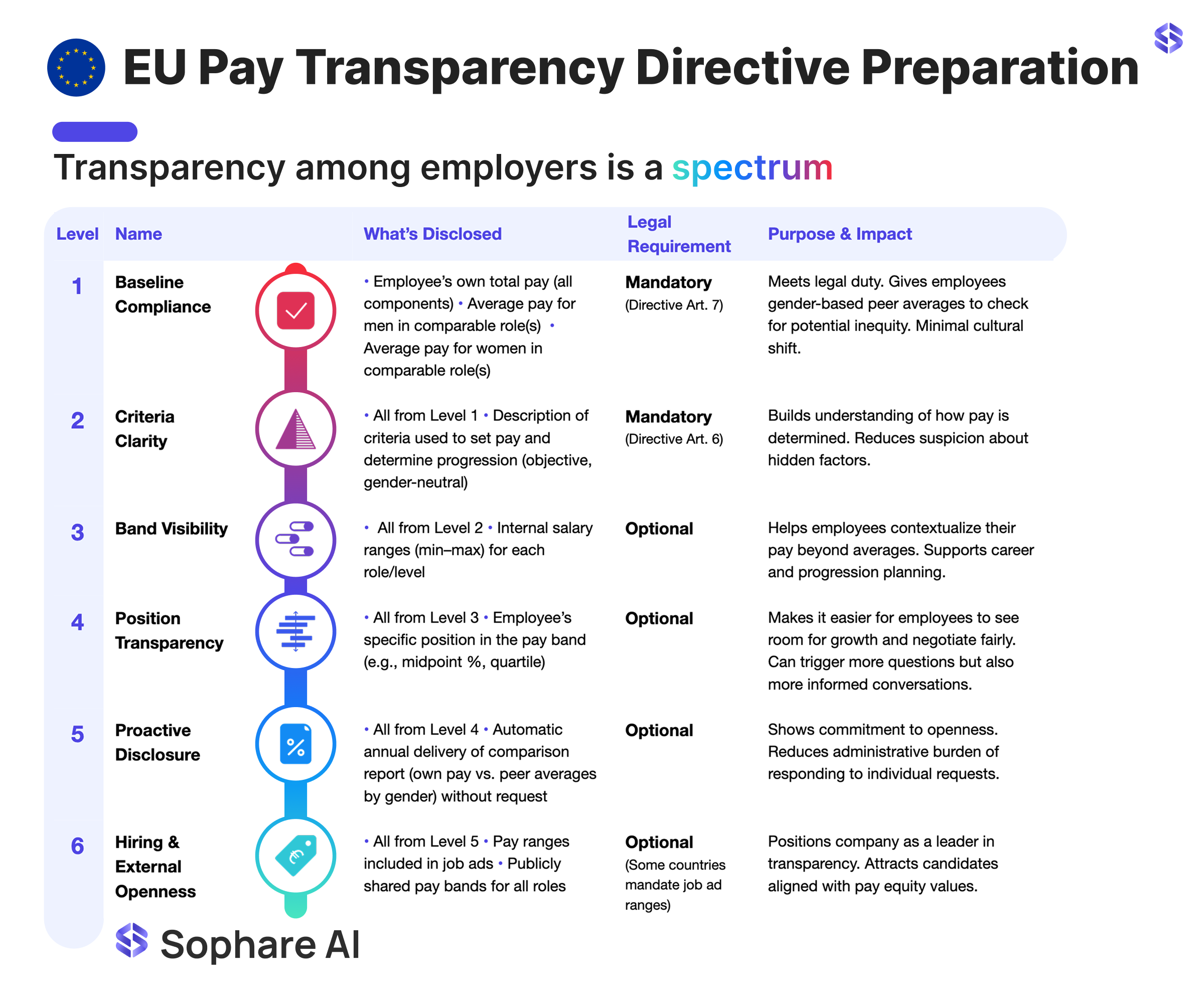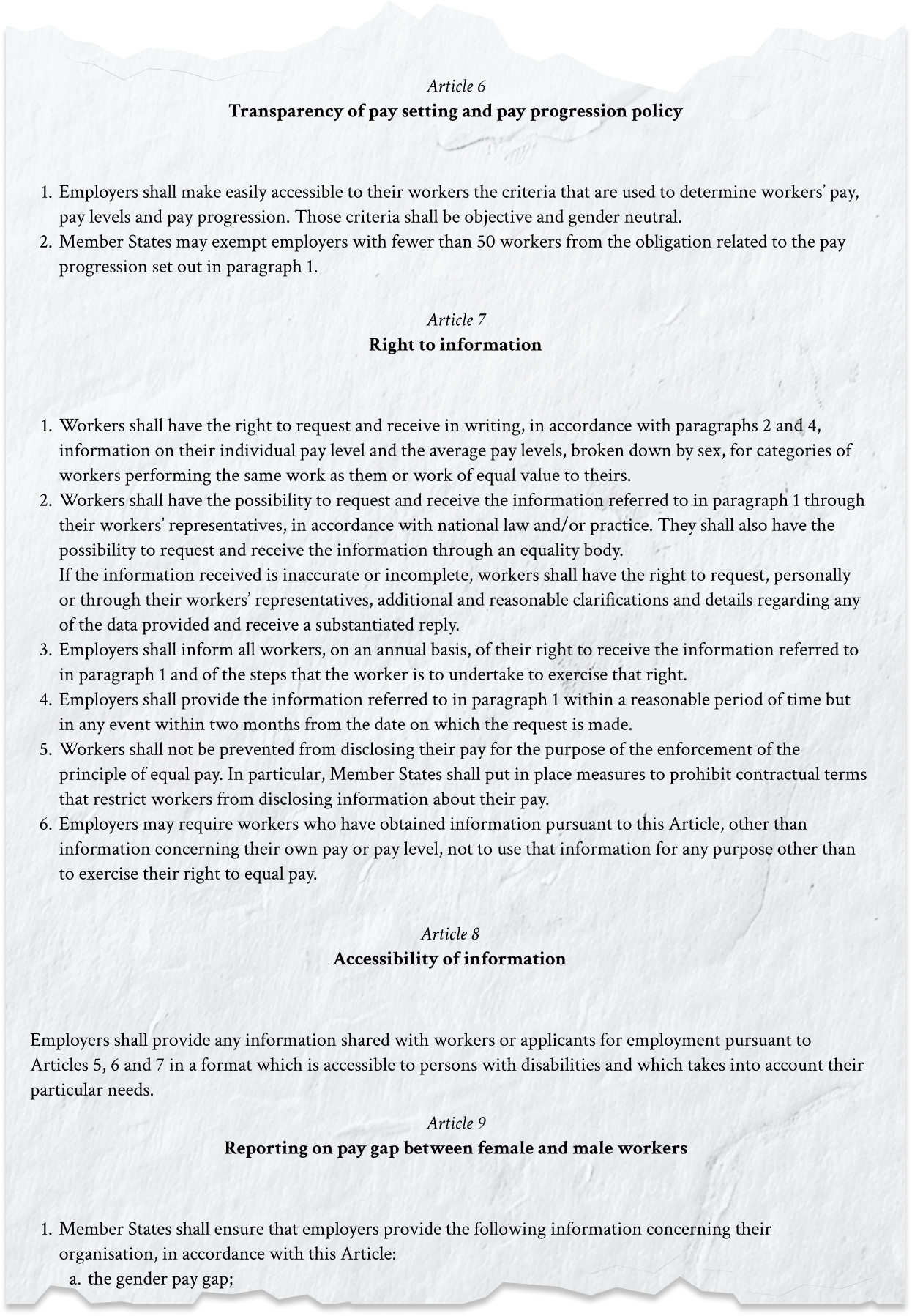Your Position on the EU Pay Transparency Spectrum
The EU Pay Transparency Directive (Directive (EU) 2023/970) introduces new rights for employees to obtain information about pay, and is aimed at enforcing equal pay for equal work between men and women. A key provision is that workers will have a “right to information” (Article 7) about their own pay and how it compares to the pay of peers in similar roles.
In this article, we explain what the directive requires and how member states are putting the rules into practice. We outline exactly what employers must disclose, what they may choose to share, and practical steps to meet these obligations. We also explore how going beyond the legal minimum can build employee trust and confidence in pay decisions and lower the risk of costly pay disputes.
To make those conversations easier, we’ve developed a six-point transparency spectrum that compensation leaders and executives can use to map the current stance and set future ambitions. The scale is not a ranking or a judgment. Every point on the spectrum is a valid choice, from meeting the letter of the law to adopting a fully open-pay model. The goal is to give teams a common language to discuss where they are today, where they’d like to be, and how that aligns with their broader compensation philosophy. What matters across the spectrum is to build processes that scale efficiently. Compliance work should always reach economies of scale so that as requirements expand across countries and headcount, the effort gains efficiency rather than adding unnecessary cost.

Click to view the Transparency Spectrum table
| Level | Name | What’s Disclosed | Legal Requirement | Purpose & Impact |
|---|---|---|---|---|
| 1 | Baseline Compliance | Employee’s own total pay (all components). Average pay for men in comparable role(s). Average pay for women in comparable role(s). | Mandatory (Directive Art. 7) | Meets legal duty. Gives employees gender‑based peer averages to check for potential inequity. Minimal cultural shift. |
| 2 | Criteria Clarity | All from Level 1. Description of criteria used to set pay and determine progression (objective, gender‑neutral). | Mandatory (Directive Art. 6) | Builds understanding of how pay is determined. Reduces suspicion about hidden factors. |
| 3 | Band Visibility | All from Level 2. Internal salary ranges (min–max) for each role/level. | Optional | Helps employees contextualize their pay beyond averages. Supports career and progression planning. |
| 4 | Position Transparency | All from Level 3. Employee’s specific position in the pay band (e.g., midpoint %, quartile). | Optional | Makes it easier for employees to see room for growth and negotiate fairly. Can prompt more questions yet better dialog. |
| 5 | Proactive Disclosure | All from Level 4. Automatic annual delivery of a comparison report (own pay vs. peer averages by gender) without request. | Optional | Shows commitment to openness. Reduces administrative burden of responding to individual requests. |
| 6 | Hiring & External Openness | All from Level 5. Pay ranges included in job ads. Publicly shared pay bands for all roles. | Optional (some countries mandate job‑ad ranges) | Positions company as a leader in transparency. Attracts candidates aligned with pay equity values. |
How to Use This Scale
-
Legal Floor Levels 1 and 2 are required by the EU Pay Transparency Directive by June 7, 2026
-
Strategic Choices Levels 3–6 are voluntary in most countries but can improve trust, employee engagement, and employer brand
-
Calibration Companies can decide whether to move incrementally up the spectrum or make a bigger leap, depending on readiness, culture, and competitive considerations
-
Data Protection Any information shared with employees must comply with the EU General Data Protection Regulation (GDPR). Data should be processed only to apply the principle of equal pay, and not for unrelated purposes
-
Consistency Across Borders If operating in multiple EU countries, track national transposition laws to see if any “optional” measures become mandatory locally
What is the EU Pay Transparency Directive asking for?
Let’s break down the directive text itself.

Under the directive, employees (workers) in EU countries have the right to request and receive certain pay information from their employer. Specifically, upon an employee’s request, the employer must provide in writing:
- The employer’s objective and gender-neutral criteria that is used to determine pay and pay progression
- The worker’s own pay level (their current gross annual compensation)
- The average pay level of the worker’s coworkers, broken down by sex, where coworkers share the worker’s job category (defined as equal work, or work of equal value). Note this does not require disclosing any individual pay, only the average
Employers must respond in writing to these requests within 2 months, and must inform workers of their right to access this information on an annual basis.
Employers with fewer than 50 workers may be exempt from disclosing pay progression criteria – check with the relevant Member State!
The directive also instructs that workers should be protected by Member States from employment contracts that prohibit workers from disclosing their pay. However, employers may require their workers to not use the information regarding others’ pay level for anything other than exercising their right to equal pay. In short, that means you can prevent your employees from posting average pay levels on Glassdoor!
Still uncertain about what this all means? Let’s get into the details.
What are we treating as ‘pay’?
The directive defines “pay” broadly to include all forms of compensation and benefits; not just base salary, but also bonuses, stock/equity awards, allowances, and other financial benefits. Employers should therefore include all relevant components of remuneration when providing pay information. For example, if bonuses or other pay elements are common in the role, the average provided should reflect total earnings, not just base pay.
What are we treating as ‘pay progression’?
The directive defines ‘pay progression’ as the process of how a worker moves to a higher pay level. Amongst other criteria, common factors include individual performance, skills development and seniority. You may wish to consider worker tenure, grade, internal and external experience, skills, education, professional certifications and performance.
Some Member States may provide ready-made templates to support your compliance with providing this information.
Are there any exemptions?
No matter the size of the company, this right-to-know applies for all employees within an EU Member State. Unlike the directive’s pay gap reporting obligations (which apply only to employers above certain employee thresholds), even small employers must comply with individual pay information requests.
Some Member States may choose to exempt smaller companies from disclosing pay progression criteria. You should check the worker’s Member State rules at the time.
Importantly, to comply with GDPR, the employer should not directly share that identifying data with the requesting employee if by fulfilling a request exactly as asked would effectively reveal a specific coworker’s salary (for example, if a comparison group has only one person of a given gender, making the “average” for that gender basically that one person’s pay) (Article 12). Instead, in such cases the information can be provided to the employee’s representatives or an equality body/inspectorate, who can then advise the employee whether there is a potential equal pay issue. This ensures transparency does not come at the cost of individual privacy.
However, employers do not have to tell each employee their exact percentile or position within a pay band. There is no explicit legal obligation to say “you are paid at the 60th percentile of your salary range,” for instance. The required piece is the average pay of peers by sex, which inherently lets an employee gauge whether they are above or below those peer averages. You may choose to voluntarily provide a percentile or position within a pay band.
Does the worker have a right to respond?
If a worker feels that the information provided is incomplete or unclear, the directive gives them the right to request additional details or clarification and to receive a reasoned, substantiated response. For instance, if the employee thinks the data is missing some component (or if they suspect the employer gave an overly broad group that hides a pay gap), they can ask for more explanation. Employers should be prepared to explain how the figures were calculated or provide further breakdowns if reasonably needed.
While an employer doesn’t initially have to provide a detailed justification for why an employee’s pay might differ from the average, they should have those justifications ready (especially if a worker asks follow-up questions or if a dispute arises). The directive shifts the burden of proof onto employers in discrimination cases – meaning if an employee alleges an unjust pay gap, the employer must prove it’s due to legitimate factors. Having transparent criteria (like skill, performance, seniority, etc.) that are consistently applied will be crucial. Some Member States may explicitly require that the employer also provide an explanation if requested for any significant differences. Even where not explicitly required, it’s wise for employers to accompany the data with an offer to discuss or explain how pay is determined. This proactive communication can preempt misunderstandings.
Frequently Asked Questions (FAQ)
When does the EU Pay Transparency Directive take effect?
The directive must be transposed by EU Member States by June 7, 2026. See our earlier article 10 Months to Go: Why August 2025 Is the Time to Begin Your EU Pay Transparency Directive Prep for a compliance timeline starting now.
Who is covered by the EU Pay Transparency Directive?
All employees working in EU Member States are covered. Some obligations, like pay gap reporting, apply only to larger employers, but the individual right to request pay information applies to all companies regardless of size.
What information must employers provide to employees?
Employers must share the employee’s own pay level, the average pay of coworkers by sex in comparable roles, and the gender-neutral criteria used for pay and progression decisions.
Do employers need to disclose exact salaries of coworkers?
No. Employers only provide averages broken down by sex for comparable job categories. Individual salaries do not need to be disclosed.
How should companies prepare for compliance?
Companies should review their pay structures, document objective and gender-neutral pay criteria, implement efficient reporting processes, and track local national laws to ensure timely compliance.

